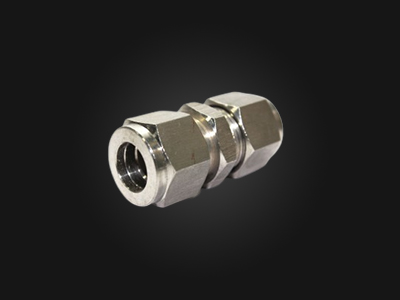REDUCING UNION
Nexus Alloys & Steels stands out as a leading producer and exporter specializing in premium Reducing Union Tube Fittings. These fittings play a crucial role in connecting tubes with varying outer diameters, a common requirement in industries like large-scale engineering pipelines, cement manufacturing facilities, and power plants. Notably, the fittings they offer are of the compression type, which is highly favored for securely joining piping assemblies.


Description:
A reducing union is a type of pipe or tube fitting designed to connect two pipes or tubes of different sizes while allowing for easy disassembly and reassembly. This fitting is commonly used in plumbing, industrial, and mechanical applications where fluid or gas flow needs to be controlled or redirected. The primary purpose of a reducing union is to provide a reliable joint between pipes or tubes with varying diameters, enabling the transition from a larger pipe size to a smaller one or vice versa.
Key Features of Nexus Alloys and Steel REDUCING UNION:
• Size Transition: Reducing union tube fittings are designed to connect tubes or pipes with different outer diameters. They smoothly transition from a larger diameter to a smaller one or vice versa.
• Versatility: These fittings are versatile and adaptable, making them suitable for various applications and industries where pipes of different sizes need to be joined.
• Disassembly and Reassembly: One of the primary features is the ability to easily disassemble and reassemble the fitting. This is essential for maintenance, repairs, or system modifications without requiring cutting or altering the tubes.
• Separable Components: Reducing unions consist of three main parts – two compression or threaded fittings on the ends and a central nut. This design enables straightforward assembly and disassembly.
• Leak-Proof Seal: Compression-type reducing unions often incorporate seals, O-rings, or gaskets that create a secure and leak-proof connection between the pipes. This ensures the integrity of fluid or gas containment.
• Materials: These fittings are available in various materials, including metals like stainless steel, brass, and copper, as well as plastics like PVC and PTFE. Material selection depends on factors such as the fluid being transported and environmental conditions.
• Threaded or Compression Design: Reducing unions can have either threaded or compression designs. Threaded versions have male and female threads for screwing together, while compression types use compression fittings for a tight seal.
• Application Range: Reducing union tube fittings find applications in industries such as plumbing, HVAC, chemical processing, oil and gas, and more. They are particularly useful in systems where adaptability and modification are crucial.
• Easy Installation: Installing a reducing union involves connecting the tubes using the provided fittings and tightening the central nut. The compression action creates a secure connection without the need for soldering or welding.
• Durable and Reliable: These fittings are built to withstand various pressures and fluid types, ensuring a durable and reliable connection over time.
• Prevention of Pipe Strain: Reducing unions can help prevent pipe strain by allowing pipes with different diameters to be connected without causing unnecessary stress on the system.
• Maintenance Flexibility: The ability to quickly disconnect and reconnect pipes using reducing unions makes maintenance tasks more efficient, minimizing downtime.
• Cost-Efficiency: Reducing unions can eliminate the need for custom-made pipe transitions, which can be costlier and more time-consuming.
Application across Industries:
• HVAC (Heating, Ventilation, and Air Conditioning): HVAC systems often require the connection of pipes with different diameters to optimize airflow, coolant circulation, or refrigerant flow. Reducing unions facilitate these transitions without disrupting the system’s functionality.
• Chemical Processing: In chemical processing plants, reducing unions play a crucial role in connecting pipes that transport different chemicals or fluids. The ability to disassemble and reassemble the fittings is valuable for maintenance and changing processes.
• Oil and Gas Industry: The oil and gas industry utilizes reducing unions in pipelines and equipment where varying pipe sizes need to be interconnected, especially in situations where changes in flow rates or directions occur.
• Manufacturing: In manufacturing processes, reducing unions are employed to connect pipes in systems that transport liquids, gases, or chemicals, ensuring efficient production and preventing leaks.
• Power Plants: Power generation facilities use reducing unions in cooling systems, water supply networks, and fuel lines to maintain proper fluid flow and optimize energy production.
• Petrochemical Industry: The petrochemical sector relies on reducing unions to connect pipes that transport raw materials, intermediates, and final products, ensuring a safe and efficient flow of materials.
• Pharmaceutical Industry: In pharmaceutical manufacturing, where sterile and controlled environments are crucial, reducing unions enable the connection of different-sized pipes for fluid and chemical transfer.
• Construction: During construction projects, reducing unions are useful for connecting pipes of various diameters in building infrastructure, water supply, and drainage systems.
• Automotive Industry:In vehicle manufacturing and assembly lines, reducing unions are employed to connect pipes in fluid systems, such as brake lines and hydraulic systems.
• Wastewater Management: Reducing unions are utilized in wastewater treatment plants to connect pipes and ensure the proper flow of wastewater and treatment chemicals.
Specification:
- Size : 1/16″ to 2 1/2″ inch
- SS Tube Fittings : Gr.304, 304H, 309, 310, 316, 316L, 317L, 321, 347, 904L
- Duplex SS Tube Fittings : UNS N031803, N032750, N032760
- CS Tube Fittings : A105
- AS Tube Fittings : Gr.5, Gr.9, Gr.11, Gr.12, Gr.22, Gr.91
- Cu Ni Tube Fittings : C 70600(90:10), C 71500(70:30)
- Nickel : UNS N02200, N02201
- Monel : UNS N04400, N05500, Alloy 20
- Inconel : UNS N06600, N06601, N06625, N08800, N088010, N08825
- Hastelloy : UNS N10276, N06022, N10665, N06455
- Other Services : Silver Plating
- Specialize : Double Compression Fitting,Ball valve ,needle valve, check
- SMO 254 Grade UNS S31254
Certificates
- Test Certificate: Manufacturer Test Certificates per EN 10204 3.1 & 3.2
- ISO 14001 (Environmental Management System) and ISO 45001
- ISO 9001:2015 Certification
related products
REDUCING UNION
Nexus Alloys & Steels stands out as a leading producer and exporter specializing in premium Reducing Union Tube Fittings. These fittings play a crucial role in connecting tubes with varying outer diameters, a common requirement in industries like large-scale engineering pipelines, cement manufacturing facilities, and power plants. Notably, the fittings they offer are of the compression type, which is highly favored for securely joining piping assemblies.


Description:
A reducing union is a type of pipe or tube fitting designed to connect two pipes or tubes of different sizes while allowing for easy disassembly and reassembly. This fitting is commonly used in plumbing, industrial, and mechanical applications where fluid or gas flow needs to be controlled or redirected. The primary purpose of a reducing union is to provide a reliable joint between pipes or tubes with varying diameters, enabling the transition from a larger pipe size to a smaller one or vice versa.
Key Features of Nexus Alloys and Steel REDUCING UNION:
• Size Transition: Reducing union tube fittings are designed to connect tubes or pipes with different outer diameters. They smoothly transition from a larger diameter to a smaller one or vice versa.
• Versatility: These fittings are versatile and adaptable, making them suitable for various applications and industries where pipes of different sizes need to be joined.
• Disassembly and Reassembly: One of the primary features is the ability to easily disassemble and reassemble the fitting. This is essential for maintenance, repairs, or system modifications without requiring cutting or altering the tubes.
• Separable Components: Reducing unions consist of three main parts – two compression or threaded fittings on the ends and a central nut. This design enables straightforward assembly and disassembly.
• Leak-Proof Seal: Compression-type reducing unions often incorporate seals, O-rings, or gaskets that create a secure and leak-proof connection between the pipes. This ensures the integrity of fluid or gas containment.
• Materials: These fittings are available in various materials, including metals like stainless steel, brass, and copper, as well as plastics like PVC and PTFE. Material selection depends on factors such as the fluid being transported and environmental conditions.
• Threaded or Compression Design: Reducing unions can have either threaded or compression designs. Threaded versions have male and female threads for screwing together, while compression types use compression fittings for a tight seal.
• Application Range: Reducing union tube fittings find applications in industries such as plumbing, HVAC, chemical processing, oil and gas, and more. They are particularly useful in systems where adaptability and modification are crucial.
• Easy Installation: Installing a reducing union involves connecting the tubes using the provided fittings and tightening the central nut. The compression action creates a secure connection without the need for soldering or welding.
• Durable and Reliable: These fittings are built to withstand various pressures and fluid types, ensuring a durable and reliable connection over time.
• Prevention of Pipe Strain: Reducing unions can help prevent pipe strain by allowing pipes with different diameters to be connected without causing unnecessary stress on the system.
• Maintenance Flexibility: The ability to quickly disconnect and reconnect pipes using reducing unions makes maintenance tasks more efficient, minimizing downtime.
• Cost-Efficiency: Reducing unions can eliminate the need for custom-made pipe transitions, which can be costlier and more time-consuming.
Application across Industries:
• HVAC (Heating, Ventilation, and Air Conditioning): HVAC systems often require the connection of pipes with different diameters to optimize airflow, coolant circulation, or refrigerant flow. Reducing unions facilitate these transitions without disrupting the system’s functionality.
• Chemical Processing: In chemical processing plants, reducing unions play a crucial role in connecting pipes that transport different chemicals or fluids. The ability to disassemble and reassemble the fittings is valuable for maintenance and changing processes.
• Oil and Gas Industry: The oil and gas industry utilizes reducing unions in pipelines and equipment where varying pipe sizes need to be interconnected, especially in situations where changes in flow rates or directions occur.
• Manufacturing: In manufacturing processes, reducing unions are employed to connect pipes in systems that transport liquids, gases, or chemicals, ensuring efficient production and preventing leaks.
• Power Plants: Power generation facilities use reducing unions in cooling systems, water supply networks, and fuel lines to maintain proper fluid flow and optimize energy production.
• Petrochemical Industry: The petrochemical sector relies on reducing unions to connect pipes that transport raw materials, intermediates, and final products, ensuring a safe and efficient flow of materials.
• Pharmaceutical Industry: In pharmaceutical manufacturing, where sterile and controlled environments are crucial, reducing unions enable the connection of different-sized pipes for fluid and chemical transfer.
• Construction: During construction projects, reducing unions are useful for connecting pipes of various diameters in building infrastructure, water supply, and drainage systems.
• Automotive Industry:In vehicle manufacturing and assembly lines, reducing unions are employed to connect pipes in fluid systems, such as brake lines and hydraulic systems.
• Wastewater Management: Reducing unions are utilized in wastewater treatment plants to connect pipes and ensure the proper flow of wastewater and treatment chemicals.
Specification:
- Size : 1/16″ to 2 1/2″ inch
- SS Tube Fittings : Gr.304, 304H, 309, 310, 316, 316L, 317L, 321, 347, 904L
- Duplex SS Tube Fittings : UNS N031803, N032750, N032760
- CS Tube Fittings : A105
- AS Tube Fittings : Gr.5, Gr.9, Gr.11, Gr.12, Gr.22, Gr.91
- Cu Ni Tube Fittings : C 70600(90:10), C 71500(70:30)
- Nickel : UNS N02200, N02201
- Monel : UNS N04400, N05500, Alloy 20
- Inconel : UNS N06600, N06601, N06625, N08800, N088010, N08825
- Hastelloy : UNS N10276, N06022, N10665, N06455
- Other Services : Silver Plating
- Specialize : Double Compression Fitting,Ball valve ,needle valve, check
- SMO 254 Grade UNS S31254
Certificates
- Test Certificate: Manufacturer Test Certificates per EN 10204 3.1 & 3.2
- ISO 14001 (Environmental Management System) and ISO 45001
- ISO 9001:2015 Certification
